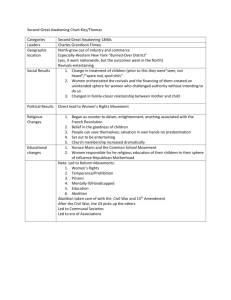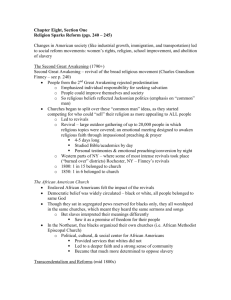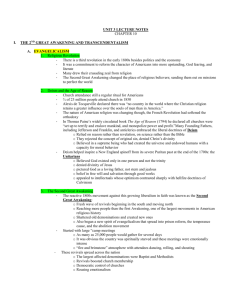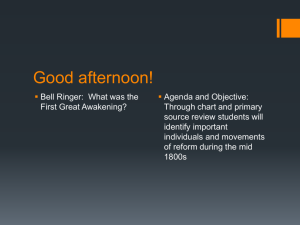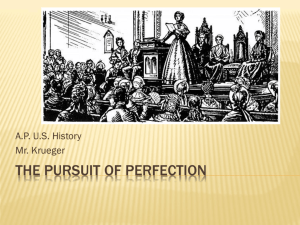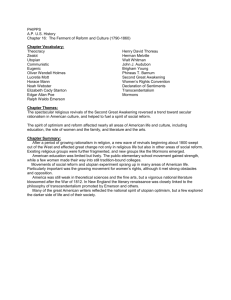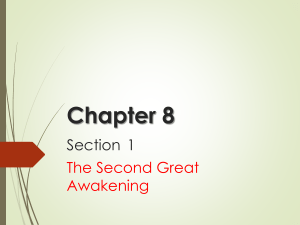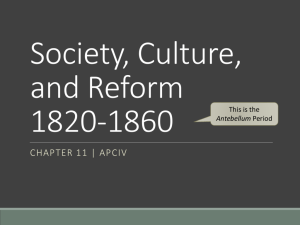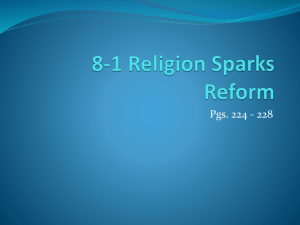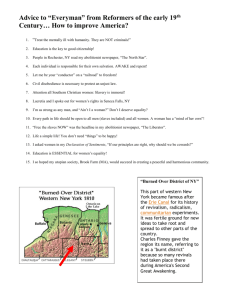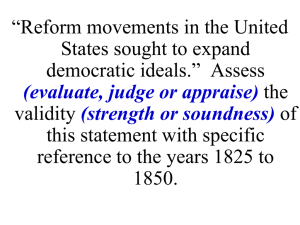LECTURE 03_The 2nd Great Awakening
advertisement
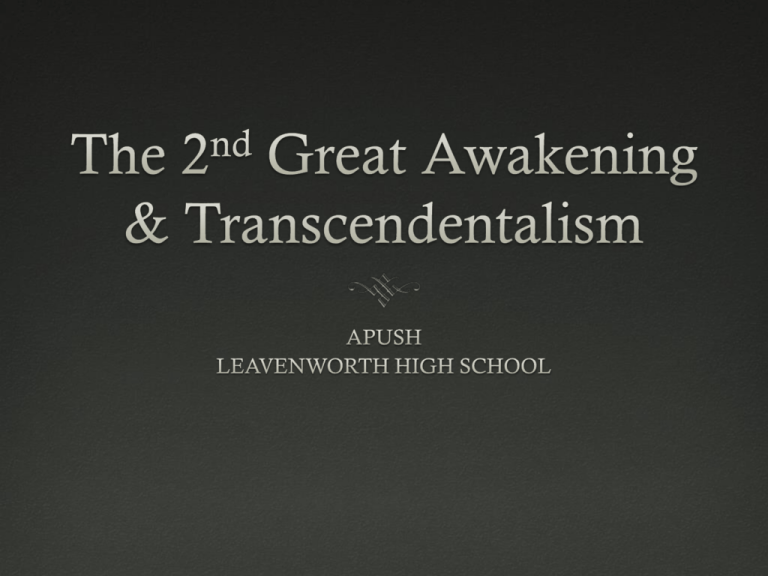
RELIGIOUS REVOLUTION There is a third revolution in the early 1800s besides politics and the economy It was a commitment to reform the character of Americans into more upstanding, God fearing, and literate Church attendance still a regular ritual for Americans ¾ of 23 million people attend church in 1850 Second Great Awakening As a result of the Second Great Awakening (a series of revivals in the 1790s-early 1800s), the dominant form of Christianity in America became evangelical Protestantism Membership in the major Protestant churches— Congregational, Presbyterian, Baptist, and Methodist— soared the Methodists emerged as the largest denomination in both the North and the South DEISM The nature of American religion was changing though, the French Revolution had softened the orthodoxy Many Founding Fathers, including Jefferson and Franklin, and anticlerics embraced the liberal doctrines of Deism Relied on reason rather than revelation, on science rather than the Bible They rejected the concept of original sin, denied Christ’s divinity Deism helped inspire a New England spinoff from its severe Puritan past at the end of the 1700s: the Unitarians Believed God existed only in one person and not the trinity; denied divinity of Jesus appealed to intellectuals whose optimism contrasted sharply with hellfire doctrines of Calvinism 1816 -> American Bible Society Founded Revivalism and the Social Order Society during the Jacksonian era was undergoing deep and rapid change The revolution in markets brought both economic expansion and periodic depressions. To combat this uncertainty reformers sought stability and order in religion Religion provided a means of social control in a disordered society Churchgoers embraced the values of hard work, punctuality, and sobriety Revivals brought unity and strength and a sense of peace Second Great Awakening The reactive 1800s movement against this growing liberalism in faith was known as the Second Great Awakening: Fresh wave of revivals beginning in the south and moving north Also began a new spirit of evangelicalism that spread into prison reform, the temperance cause, and the abolition movement Started with large “camp meetings” in the south As many as 25,000 people would gather for several days “fire and brimstone” atmosphere with attendees dancing, rolling, and shouting – EMOTIONALLY INTENSE These revivals spread across the nation The largest affected denominations were Baptist and Methodists Revivals boosted church membership Charles Finney Charles Finney conducted his own revivals in the NE in the 1830s Greatest revivalist preacher He rejected the Calvinist doctrine of predestination adopted ideas of free will and salvation to all Charles Finney and the Conversion Experience New form of revival Meeting night after night to build excitement Speaking bluntly Praying for sinners by name Encouraging women to testify (pray) in public Denounced alcohol and slavery EFFECTS Feminization of religion In terms of membership and theology Middle class women were the most fervent revival enthusiasts Were the wives and daughters of businessmen Evangelicals preached a gospel that appealed to them: female spiritual worth and the role of bringing their husbands back to God With that message many women turned their effort into saving the rest of society They formed charitable organizations and spearheaded many of the era’s reform movements Burned Over District Burned over district in Western NY got its name from a “wild fire of new religions” Gave birth to Seventh Day Adventists The Millerites believed the 2nd coming of Christ would occur on October 22, 1843 Members sold belonging, bought white robes for the ascension into heaven Believers formed new church on October 23rd Other Churches Founded While the Protestant revivals sought to reform individual sinners, others sought to remake society at large Mormons – The Church of Jesus Christ of Latter-Day Saints Founded by Joseph Smith in western NY in 1830 In 1844 Smith and his brother were murdered by a mob in Carthage Illinois The movement seemed near collapse The leadership torch was picked up by Brigham Young Mormons • Brigham Young, Smith’s successor, led the Mormons westward in 1846-1847 to Utah where they could live and worship without interference • Through irrigation methods they made the Utah desert bloom and they became a populated and prosperous group Other Religious Groups The Shakers Ann Lee – 1774 The Shakers used dancing as a worship practice Shakers practiced celibacy, separating the sexes as far as practical Shakers worked hard, lived simply (built furniture), and impressed outsiders with their cleanliness and order Lacking any natural increase, membership began to decline after 1850, from a peak of about 6000 members Utopian Communities The Oneida Community Brook Farm New Harmony The Oneida Community New York, 1848 Millenarianism --> the 2 nd John Humphrey Noyes (1811-1886) coming of Christ had already occurred. Humans were no longer obliged to follow the moral rules of the past. Key to happiness is suppression of selfishness No private property No private relationships All of these breed jealousy and quarreling Practiced “free love” all residents married to each other. Prospered due to steel and silver work Communal work according to skill ROMANTICISM Early American writing was sneered and lampooned internationally Much was plagiarized from Great Britain After 1820 young American authors began to answer the call for authentic literature Much was influenced by the arrival of Romanticism in America Emphasized imagination over reason; Nature over civilization Intuition over calculation; Self over society Emotion, expression were core values Washington Irving (1783 – 1859) The Sketch Book The Legend of Sleepy Hollow Rip Van Winkle James Fenimore Cooper (1789 – 1851) Last of the Mohicans (1826) Transcendentalism Golden Age of American literature Began in New England (Concord, Mass.) in 1830’s From 1830 to 1855 transcendentalists argued that humans are naturally good To transcend means to “rise above” Every person possesses an inner light that puts you in touch with God/“Oversoul” Self reliance, self culture, self discipline Taught that the process of spiritual discovery would lead a person to profound truths Reject outward rituals, favor inward searching This would help lead a moral life where you could help society Ralph Waldo Emerson 1803 - 1882 Leader of the transcendentalists movement Trained as a Unitarian Boston minister He began an “American Renaissance” in literature He stressed self reliance, self improvement, self confidence, optimism, and freedom Try to improve the world around; spent much time in reflection In “The America Scholar” speech at Harvard in 1837 he urged American writers throw off European traditions and delve into rich American tales Many of his essays started as lectures Henry David Thoreau 1817 - 1862 Among his themes were the value of leisure, living in nature, antislavery, and working for common good Condemned a government that supported slavery Refused to pay Mass. Poll tax and was jailed for a night Walden: Or Life in the Woods (1854) Records two years of simple life spent in a hut that he built on Walden Pond in Concord Mass Favored quest for isolation in nature to get away from corruptions of society Influenced Gandhi and MLK Transcendentalist Intellectuals/Writers Concord, MA Ralph Waldo Emerson Nature (1832) Self-Reliance (1841) “The American Scholar” (1837) Henry David Thoreau Walden (1854) Resistance to Civil Disobedience (1849) Walt Whitman From Brooklyn – more bold, confident, swagger Leaves of Grass (1855) Collection of poems Gave divinity to nature and human body Glorification of self http://www.youtube.com/watch?v=ABOae1jGB3w&feat ure=related ABOUT POP CULTURE Transcendentalists writers Emerson and Thoreau wrote about that the modern newspapers & novels just contained murderous stories, carried a haunted nature, and ruined the works of mankind LITERARY LIGHTS Other great works were created during this age by literary giants who were not associated with transcendentalism Professor Henry Wadsworth Longfellow (1807-1882) One of most popular American poets; popular in Europe as well Evangeline (1847); The Song of Hiawatha (1855) Louisa May Alcott (1832-1888) Little Women (1868) Emily Dickinson (1820-1886) Explored universal themes of love, death, nature, immortality DISSENTERS There were also contrary writers who did not believe so keenly in human progress and goodness Edgar Allen Poe (1808-1849) Specialized in gothic horror and detective stories The Raven (1845); The Murders in the Rue Morgue (1841) His career was cut short when found drunk in a Baltimore gutter; dying shortly after Nathaniel Hawthorne (1804 – 1864) They explored darker realms of human experience with pain, fear, grief, and the supernatural Lived in Salem, Mass. Grew up with the heavy atmosphere of Puritan ancestry The Scarlet Letter (1850) Puritan sin, romance Herman Melville (1819 – 1891) Went to sea as a youth; served 18-months as a whaler Moby Dick (1851) • Conflict between Captain Ahab and giant white whale Moby Dick EDGAR ALLEN POE http://www.youtube.com/watch?v=yIp4m_v9xGs
